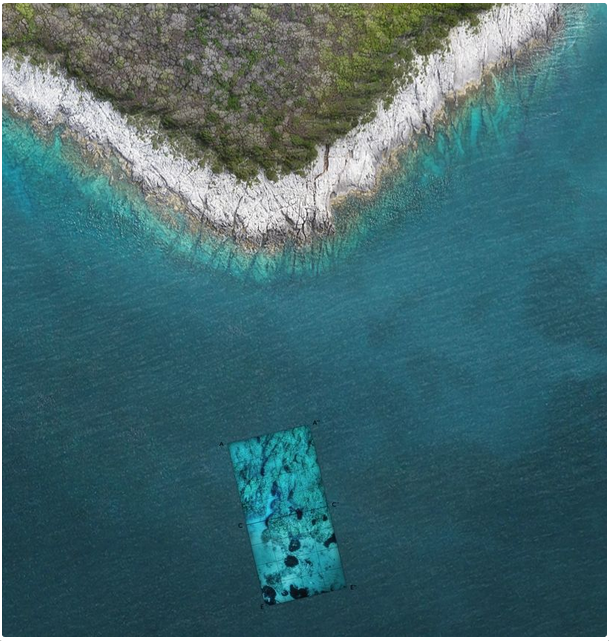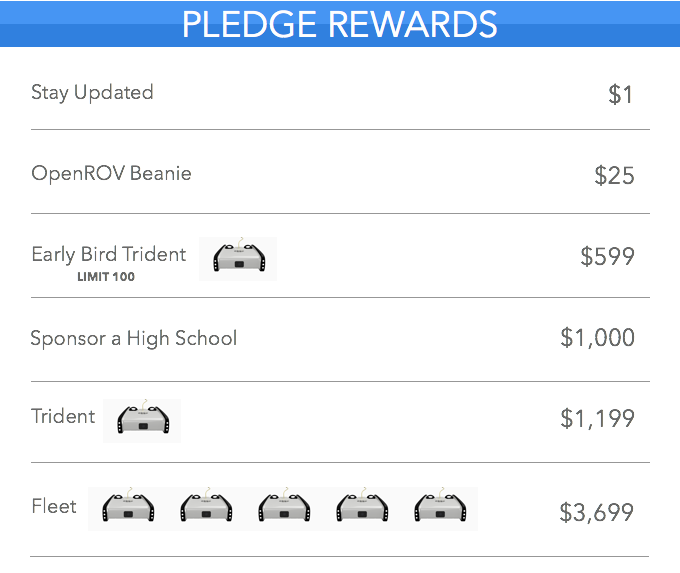OpenROV Trident - An Underwater Drone for Everyone
The future of ocean exploration is here.
From KickStarter
After four years designing and piloting underwater drones, we've taken everything we've learned and completely re-imagined what an underwater drone could be.
Trident has a unique design that combines the versatility and control of an ROV (Remotely Operated Vehicle) and the efficiency of an AUV (Autonomous Underwater Vehicle).
It can fly in long, straight survey lines called "transects" as well as perform delicate maneuvers in tight spaces, all while maintaining a sleek and powerful form factor.
Trident is easy to use and comes ready to go.
Most importantly, it is incredibly fun to fly.
(Flying really is the best term, because that's exactly what it feels like when you're piloting.)
Our Story
You may remember us.
We came to Kickstarter three years ago and shared our dream of building a low-cost underwater robot that would allow anyone and everyone to explore the world below the surface.
We have come a long way since that initial Kickstarter video.
We were working out of Eric's garage at the time, building the original prototype to explore a cave in Northern California with rumors of lost treasure (the full story can be heard in this TED talk).
We never found the gold, but we received messages from people all over the world who wanted to help us and improve the robot.
The Kickstarter project was the springboard. Since then, we've shipped thousands of OpenROV kits to people all over the world.
Community
The OpenROV community is the secret sauce.
We made our project open source in order to facilitate faster innovation cycles and allow others to improve on our initial designs.
Thousands of people have gotten involved.
You can see and follow along with the community expeditions on OpenExplorer.
Team
We've also assembled a small team that works from our OpenROV HQ in Berkeley, CA to manufacture, ship and support the robots.
The combination of community wisdom and the commitment of our internal R&D team (many of whom were original Kickstarter backers) have been the drivers in creating Trident.
At OpenROV, we talk openly about our desire to maximize "Return on Adventure."
We want to make sure that everyone who comes in contact with our project - community members, customers, employees, whoever - feels that their world is more interesting and more exciting because of it.
We want to give people a sense of wonder about how much out there is yet to be explored and make it possible for anyone to be a part of exploring it.
Trident is our best attempt yet to fulfill that promise.
Trident Performance
Every aspect of the Trident design has been painstakingly thought out in order to optimize performance and usability in any situation.
One of the secrets of its versatility is the unique, hydrodynamically offset thruster design.
This configuration allows you to move through the water fast and efficiently when you want to rapidly search an area or run a transect, but also allows you to maneuver very delicately when in tight quarters or while looking at a particular target.
By taking advantage of drag's exponential relationship with velocity, the off-center vertical thruster of the ROV can cause it to pitch at high speeds but also hover or change depth without pitching while operating at low speeds - similar to the way a traditional ROV works.
We've designed Trident to be ultra portable and ultra durable.
The form factor is small enough to fit in a backpack or fit under an airplane seat.
The side panels are overmolded with a strong, rubber coating, which gives it protection from underwater obstacles as well as rough handling when being transported.
Depth: Capable of 100m (will ship with a 25m tether - longer tethers will be sold separately)
Mass: 2.9 kg
Top Speed: 2 m/s
Run Time: 3 hours
Mass: 2.9 kg
Top Speed: 2 m/s
Run Time: 3 hours
It uses a neutrally buoyant tether to communicate to a towable buoy on the surface (radio waves don't travel well in water) and the buoy connects to the pilot using a long range WiFi signal.
Using a wireless towable buoy greatly increases the practical range of the vehicle while doing transects and search patterns since a physical connection between the vehicle and the pilot doesn't need to be maintained.
You can connect to the buoy and control Trident using a tablet or laptop from a boat or from the shore.
Software
Our goal is to make the easiest, most intuitive telerobotic control system possible.
We have embraced the latest emerging internet standards from HTML5 and webRTC to WebVR and WebGL to deliver a rich piloting experience through just a browser that runs on laptops, tablets, and modern mobile devices.
The software that drives Trident is a living open-source project (https://github.com/openrov/openrov-software).
The same software that drives our previous ROV has been continually updated by both the community and our software team. Some of those changes included:
- Software plugins that allow any ROV enthusiast to deliver improved ROV capabilities to the whole OpenROV community via small Internet delivered update packages.
- UI Themes so that you can change the look and feel of the piloting experience.
- Depth and Heading hold. Until recently, only a feature on high end industrial ROVs, now available to everyone.
We are reviewing every bit of the user experience regarding our software to ensure the most simple and intuitive experience possible.
What's included
In each of the reward levels for a Trident, the basic package will include:
- Trident. The actual drone, ready-to-dive.
- A 25m (82 ft) tether. There's a lot to see in the first 25m of depth. For many people, that will be enough. Tethers will be removable and upgradeable if you need to go deeper.
- A wifi topside buoy. The tether connects to a wifi topside buoy. You can use this to control the ROV remotely by setting it on the water or just leaving it on the boat or dock.
- Batteries. Trident comes with onboard LiFePO4 batteries, providing a run time of over 3 hours.
*You can always get this later if you're not sure. Or only add for either the hard case or longer tether.
-
Hard Case. ($100 Add On) Trident will come in a sturdy package/box, but the Adventure Set will have a hard case for travel and shipment.
AND/OR - 100m Tether. ($250 Add On) Know you want to go deep? Get the 100m tether right out of the gate.
We built Trident to be the ultimate tool for explorers.
But we also wanted to make sure that it was useful for a whole host of utilities.
One of the most interesting new features - something that sets Trident in a class of its own - is its ability to conduct long transects, meaning it can run lawn mower patterns over large areas.
The benefit of this type of coverage is that you can create visualizations of what the seafloor looks like using photogrammetry software to create a 3D model of the work area.
Here's an example from the Fiskardo Greece Expedition run by our friends at OCTOPUS Foundation and Novalta:
Mission Fiskardo 2015 (Greece)
In the Northern part of Kefalonia island in the Ionian sea, Ocean71, Novalta and Fiskardo Divers
In the Northern part of Kefalonia island in the Ionian sea, Ocean71, Novalta and Fiskardo Divers
Whether you want to inspect an anchor line or look for shipwrecks, Trident gives you eyes underwater and adds a whole new dynamic to the experience of being on the water.
Sponsor a High School
"The OpenROV project was a winner -- igniting my inner city students' enthusiasm for exploration, taking on academic and technical challenges and developing resilience to over-come set-backs."
-Katie Noonan, Oakland High School
One of the most exciting parts of the OpenROV project has been the number of high school classes and students that have taken part.
The project provides an incredibly well-rounded education experience: mechanical and electrical engineering, programming, physics, biology, ecology, contributing to an open source community, and just getting outside into nature.
The OpenROV kit (not Trident - the previous model of kit) is still an excellent tool for education (and other uses that require the hack-ability).
We have a long list of well-deserving classrooms that can do wonders with a donated OpenROV kit. The reward pledge at the $1,000 level will further our efforts here.
It will allow us to send a kit and build materials to one of these schools.
If you're a resource-constrained teacher who'd like to be added to this list, please email info@openrov.com with the subject "I'm a teacher!"
Where We're At
We have spent the last two years developing the Trident, engineering dozens of prototypes to get to what you see today.
We are currently working on refining the final design and tuning it for manufacturing with veteran mechanical engineers and industrial designers.
We have developed relationships with manufacturing partners for the components and subsystems of Trident and now we need your support to help make it a reality!
Links :
- GeoGarage blog : OpenROV will change exploration of last true frontier /











No comments:
Post a Comment